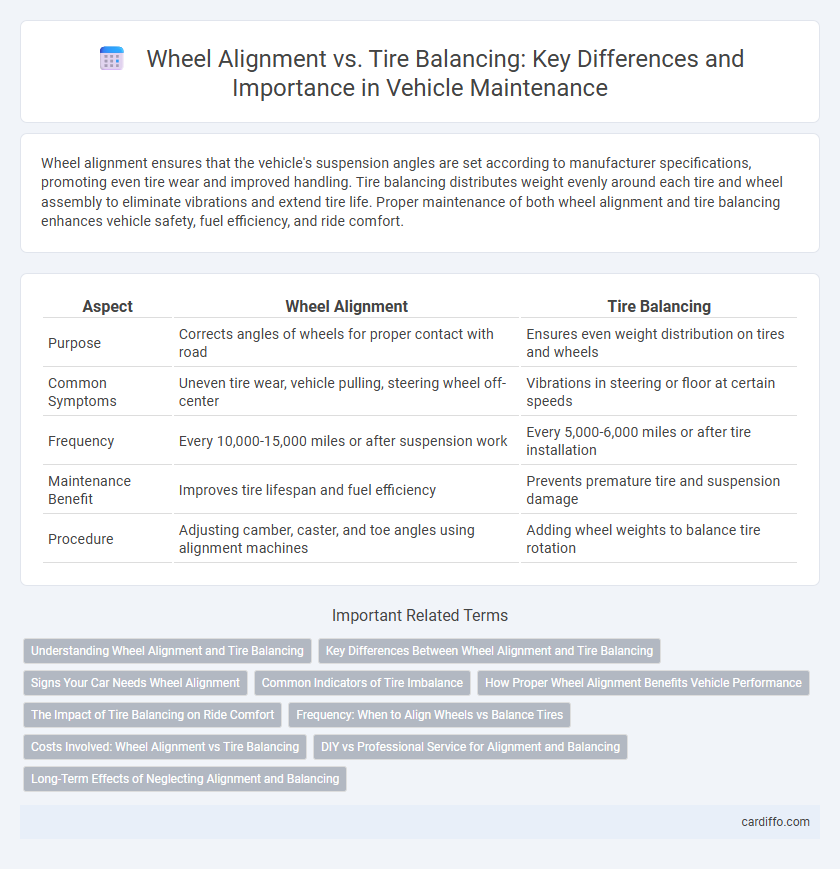Wheel alignment ensures that the vehicle's suspension angles are set according to manufacturer specifications, promoting even tire wear and improved handling. Tire balancing distributes weight evenly around each tire and wheel assembly to eliminate vibrations and extend tire life. Proper maintenance of both wheel alignment and tire balancing enhances vehicle safety, fuel efficiency, and ride comfort.
Table of Comparison
| Aspect | Wheel Alignment | Tire Balancing |
|---|---|---|
| Purpose | Corrects angles of wheels for proper contact with road | Ensures even weight distribution on tires and wheels |
| Common Symptoms | Uneven tire wear, vehicle pulling, steering wheel off-center | Vibrations in steering or floor at certain speeds |
| Frequency | Every 10,000-15,000 miles or after suspension work | Every 5,000-6,000 miles or after tire installation |
| Maintenance Benefit | Improves tire lifespan and fuel efficiency | Prevents premature tire and suspension damage |
| Procedure | Adjusting camber, caster, and toe angles using alignment machines | Adding wheel weights to balance tire rotation |
Understanding Wheel Alignment and Tire Balancing
Wheel alignment involves adjusting the angles of the wheels to ensure they are set to the car manufacturer's specifications for optimal contact with the road, preventing uneven tire wear and improving handling. Tire balancing distributes the weight of the tire and wheel assembly evenly around the axle, reducing vibrations and extending tire life. Both procedures are essential for vehicle safety, but wheel alignment corrects directional accuracy while tire balancing targets rotational stability.
Key Differences Between Wheel Alignment and Tire Balancing
Wheel alignment adjusts the angles of the wheels to the manufacturer's specifications, ensuring proper tire contact with the road and preventing uneven tire wear. Tire balancing involves equalizing the weight distribution around the tire and wheel assembly to reduce vibrations and improve ride quality. Proper wheel alignment optimizes steering accuracy and tire longevity, while tire balancing enhances vehicle stability and prevents premature bearing wear.
Signs Your Car Needs Wheel Alignment
Uneven tire wear, such as excessive wear on one edge of the tire, signals the need for wheel alignment to prevent further damage. Steering wheel vibration or pulling to one side during driving indicates misalignment affecting vehicle control and safety. Persistent drifting or drifting despite flat roads confirms the car requires professional wheel alignment maintenance.
Common Indicators of Tire Imbalance
Uneven tire wear, steering wheel vibration at high speeds, and pulling to one side while driving are common indicators of tire imbalance. Wheel alignment issues often cause inconsistent tire wear patterns, but tire balancing specifically addresses vibrations caused by weight discrepancies in the tire and wheel assembly. Proper maintenance includes checking for these signs to ensure optimal vehicle performance and extended tire life.
How Proper Wheel Alignment Benefits Vehicle Performance
Proper wheel alignment enhances vehicle performance by ensuring optimal tire contact with the road, which improves handling, fuel efficiency, and tire longevity. It reduces uneven tire wear, preventing premature tire replacement and maintaining safety through better traction. Unlike tire balancing, wheel alignment focuses on the angles of the wheels, directly impacting steering precision and overall driving stability.
The Impact of Tire Balancing on Ride Comfort
Tire balancing significantly enhances ride comfort by ensuring even weight distribution across all tires, which reduces vibrations felt inside the vehicle. Properly balanced tires minimize uneven tire wear and prevent steering wheel shimmy, resulting in a smoother and quieter driving experience. Consistent tire balancing also extends tire lifespan and improves overall vehicle stability, directly contributing to driver and passenger comfort.
Frequency: When to Align Wheels vs Balance Tires
Wheel alignment should be performed every 12,000 to 15,000 miles or if uneven tire wear, steering pull, or vibration occurs, ensuring optimal vehicle handling and tire longevity. Tire balancing is typically recommended every 5,000 to 6,000 miles or when experiencing vibrations at higher speeds, maintaining smooth ride quality and preventing premature tire wear. Regularly assessing both wheel alignment and tire balancing according to these frequencies enhances driving safety and extends tire lifespan.
Costs Involved: Wheel Alignment vs Tire Balancing
Wheel alignment typically costs between $75 and $100 per vehicle, covering adjustments to the angles of the wheels to ensure proper contact with the road. Tire balancing usually ranges from $10 to $20 per tire, involving the redistribution of weight to eliminate vibrations during driving. Choosing between wheel alignment and tire balancing depends on symptoms and vehicle performance, but alignment tends to be pricier due to the more complex adjustment process.
DIY vs Professional Service for Alignment and Balancing
Wheel alignment requires precision equipment to adjust suspension angles for optimal tire contact, making professional service essential for accurate results and preventing uneven tire wear. Tire balancing, involving redistributing tire weight to reduce vibrations, can be approached as a DIY task with basic balancing kits but often benefits from professional dynamic balancing machines for smoother rides. Choosing between DIY and professional services depends on the tools available and the importance of precision, with alignment generally demanding expert intervention while balancing offers more flexibility for self-maintenance.
Long-Term Effects of Neglecting Alignment and Balancing
Neglecting wheel alignment leads to uneven tire wear, compromised handling, and increased fuel consumption, causing premature tire replacement and costly repairs. Ignoring tire balancing results in vibrations that damage suspension components and reduce driving comfort over time. Consistent maintenance of both ensures vehicle stability, prolongs tire life, and optimizes overall safety and performance.
Wheel Alignment vs Tire Balancing Infographic

 cardiffo.com
cardiffo.com